| Pages:
1
2
3
4
5 |
bulerias1981
Oud Junkie
    
Posts: 771
Registered: 4-26-2009
Location: Beacon, NY
Member Is Offline
Mood: John Vergara Luthier Lord of the Strings instrument making and repair
|
|
Quote: Originally posted by jdowning  | | The second oud geometry is that of the Al- Arja oud that compares closely with a late 15th C carving of a lute in Ulm Cathedral, Germany.
|
I'm interested in knowing more about this geometry.
Are there other ouds besides the Al-Arja oud using this layout for the bowl?
Based on your analysis breakdown of the pattern, there seems to be only two radii to complete the bowl. Is this a simplfied version of the Arnault de
Zwolle example?
Would this be considered the most elementary pattern for a lute?
This seems to be using the same pattern. I assume early lutes used the semi-circular, two radii pattern for their layout.

|
|
|
jdowning
Oud Junkie
    
Posts: 3485
Registered: 8-2-2006
Location: Ontario, Canada
Member Is Offline
Mood: No Mood
|
|
The Arnault de Zwolle geometry is not the same as the Al-Arja geometry - as can be appreciated from previous postings.
The de Zwolle profile uses an upper sound board profile with an arc of radius equal to the sound board width (4 units) whereas the Al-Arja upper sound
board profile has an arc of radius equal to 5 units - based upon a 3:4:5 Pythagorean right triangle.
The de Zwolle geometry is suspect. For example, the sound hole diameter shown in the diagram is not 1/3 the sound board width as stated in the text.
The bridge placement stated as being at 1/6 the length of the sound board in the text is not reflected in the geometry of the diagram. Other
proportions also seem to be a compromise or approximation. So - build a lute on this information if you wish - but it may not represent a lute (or
oud) of the late Medieval period.
|
|
|
jdowning
Oud Junkie
    
Posts: 3485
Registered: 8-2-2006
Location: Ontario, Canada
Member Is Offline
Mood: No Mood
|
|
Although the Arnault de Zwolle geometry is inconsistent and so does not exactly represent 'Pythagorean' harmonic proportions, the sound board profile
is interesting and cause for further investigation.
The profile of Arnault's lute is 'egg shaped' i.e. oval - created from a circle and the blending of two arcs for the upper sound board profile - the
primary arc being equal to the diameter of the circle.
So far this investigation has concentrated upon upper sound board profiles created with simple arcs of varying radii.
In an article "Lute Design and the Art of Proportion" (Appendix 4 of 'Lutes, Viols and Temperaments', by Mark Lindley, Cambridge University Press,
1984, 2009) Gerhard C. Söhne - who has studied the geometries of many of the surviving lutes of the 16th and 17th C - observes that some lutes of the
late 16th C had an upper sound board profile that was not a simple arc but elliptical.
He concludes that about a third of the surviving lutes lend themselves to relatively precise geometrical analysis - the remainder of the lutes being
in too bad a shape to determine the intended geometry or - in cases of some well preserved lutes by renowned luthiers - the design appears to have
been created without any known geometrical method.
More to follow.
|
|
|
jdowning
Oud Junkie
    
Posts: 3485
Registered: 8-2-2006
Location: Ontario, Canada
Member Is Offline
Mood: No Mood
|
|
For over two thousand years, the geometry attributed to the Greek mathematician Euclid - published in his textbook the 'Elements' - hold true (unless
you are a present day nuclear physicist or 'rocket scientist' concerned with the effects of gravitational fields or 'relativity theory').
Euclid's geometrical theorems seem to be so obvious that they appear to be true in absolute terms to the extent that they have been attributed magical
or divine significance - representing universal harmony.
All of the constructions and proofs of Euclid's geometry are accomplished only with a pair of dividers and a straight edge (without any units or
divisions). The reason being that the ancient Greeks only understood whole numbers not fractions.
|
|
|
jdowning
Oud Junkie
    
Posts: 3485
Registered: 8-2-2006
Location: Ontario, Canada
Member Is Offline
Mood: No Mood
|
|
It is likely that both early oud and lute makers designed their instruments from first principles based upon Euclidean geometry - using only a compass
and straightedge - and a belief in the proportions of universal harmony.
The sound boards of some of the earliest surviving lutes still bear the scribed layout marks of dividers used to determine bridge and bracing
layouts.
The attached images (copyright of the Trustees of the British Museum) are of the well known late 16th C engraving of renowned luthier Gaspar
Duiffoprugcar (Italianate name of the German Tieffenbrücker family of lute makers) showing the variety of instruments made by this maker. Note the
prominent display of a pair of dividers in the maker's hands - clearly an important tool for this 16th C luthier.
For information, the Latin text at the bottom of the engraving translates as :
"I was alive in the forest; I was cut down by the cruel axe; In life I was silent; In death I sweetly sing"
- referring, of course, to the wood from which stringed musical instruments are made.
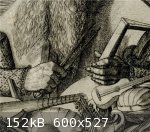
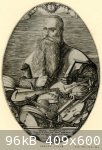
|
|
|
jdowning
Oud Junkie
    
Posts: 3485
Registered: 8-2-2006
Location: Ontario, Canada
Member Is Offline
Mood: No Mood
|
|
Like many artists, architects and craftsmen of his time the famed 16th C German artist Albrecht Dürer (1471 - 1528) sought methods for producing
various geometrical forms. Dürer published four books on geometry the " Underweysung der Messung ..."
The true ellipse shape is not easily created using just dividers and a straight edge. The asymmetric form of an ellipse is egg shaped and so was of
particular interest to the artist and craftsman.
The attached image (#34) by Dürer shows the construction of a true ellipse derived from the section of a cone. Dürer, however, was confused in
thinking that this construction should form an egg shape (wider at the bottom than the top).
However, just as eggs in nature can range in shape from almost a sphere to an elongated profile, oval shapes are not precisely defined like an
ellipse. An oval shape can be easily created using just a compass and straight edge by smoothly blending together a number of simple arcs. Indeed it
is possible to replicate a true ellipse profile very closely with an oval construction - hence, no doubt, Dürer's confusion.
The attached image is one example given by Dürer of an oval shape. Note how 'lute like' the shape is - indeed the proportions are almost identical to
those given for an oud in the 9th C by Ikhwan al-Safa.
Trying to accurately create a lute upper sound board profile as a true ellipse is complicated. Creating an oval profile, on the other hand, is simple
and so is perfectly adapted for describing an 'elliptical like' lute sound board profile using only compass and straight edge.
This upper sound board profile is well adapted for a late
16th C lute with wide neck carrying up to 10 double string courses but looks distinctly odd and out of proportion if a narrow neck is attached as in
the Arnault de Zwolle lute. And so would likely also look out of place on a Mediaeval oud
Lets look next at some other oval constructions using Euclidean geometry.

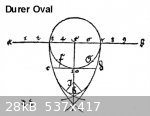
|
|
|
jdowning
Oud Junkie
    
Posts: 3485
Registered: 8-2-2006
Location: Ontario, Canada
Member Is Offline
Mood: No Mood
|
|
There are many methods used to construct oval shapes based upon intersecting arcs with tangents in alignment.
The attached image is just one example based upon three intersecting circles of equal radius (forming two so called 'vesica pisces'). The construction
is very simple and self explanatory.
This form of an oval matches that of the frame used by the original engraver - Pierre Woeiriot, 1562 - of Gaspar Duiffoprugcar's portrait previously
posted.
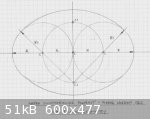
|
|
|
jdowning
Oud Junkie
    
Posts: 3485
Registered: 8-2-2006
Location: Ontario, Canada
Member Is Offline
Mood: No Mood
|
|
An even simpler example of an oval construction based upon two intersecting circles of equal radius to produce a 'vesica piscis' (see previous
postings for details) - a form regarded by many ancient societies as having sacred significance.
The attached image shows the geometry. Simple and quick to construct this oval was recommended for its beautiful proportions by 16th C architect
Sebastiano Serlio in his publication "Tutte l'Opere d'Architettura".
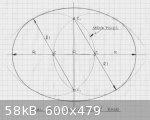
|
|
|
jdowning
Oud Junkie
    
Posts: 3485
Registered: 8-2-2006
Location: Ontario, Canada
Member Is Offline
Mood: No Mood
|
|
A 'Vesica Piscis' profile itself can also form the basis of an asymmetric oval as shown in the attached image. Again the construction is
straightforward and - lo and behold - this is the construction used by Arnault de Zwolle in the mid 15th C for his lute.
About a hundred years earlier an engraving of an oud - included in a late copy of Kitab al-Adwar by Safi al-Din - uses the same construction but
without the rounding of the top part of the sound board at the neck joint.
Arnault de Zwolle's lute with its narrow neck looks odd while Safi al-Din's oud looks to be correctly proportioned for both an oud and lute of the
late Medieval period - to judge from the iconography of the time.
So was Arnault de Zwolle working from incomplete information (or memory) having seen an oud and assumed that the profile should (ideally) have been
egg shaped? Or was the European lute an instrument developed quite independently from the oud? After all a lute does look similar to an oud so perhaps
has been assumed by historians to be an instrument derived directly from the oud through some kind of Darwinian 'origin of the species' theory applied
to musical instruments. If so, where is the concrete evidence in support of this thesis?
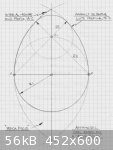

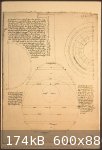
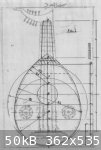
|
|
|
jdowning
Oud Junkie
    
Posts: 3485
Registered: 8-2-2006
Location: Ontario, Canada
Member Is Offline
Mood: No Mood
|
|
The attached image is of a late 16th C lute by German maker Michielle Harton , working in Padua, Italy, illustrating the 'ellipse like' profile of the
upper sound board that distinguished the design of many surviving lutes of this period - e.g by the German Tieffenbrücker family of luthiers.
Although some researchers claim that the upper sound board profile of these lutes is a true ellipse (as they may well be) creating an elliptical
profile to fit a particular instrument size is not a straightforward procedure.
The question, therefore, is did the luthiers of this period use a simpler procedure to produce a very close approximation to an ellipse (i.e. an oval)
using only dividers and a straightedge?
This theory will now be tested using as reference some full size museum drawings of surviving lutes of the late 16th C. that I have on file.
Another related question - addressed to forum members. Are there any surviving old ouds that appear to have the same or similar upper sound board
profiles to these lutes?

|
|
|
bulerias1981
Oud Junkie
    
Posts: 771
Registered: 4-26-2009
Location: Beacon, NY
Member Is Offline
Mood: John Vergara Luthier Lord of the Strings instrument making and repair
|
|
Quote: Originally posted by jdowning  |
So was Arnault de Zwolle working from incomplete information (or memory) having seen an oud and assumed that the profile should (ideally) have been
egg shaped? Or was the European lute an instrument developed quite independently from the oud? After all a lute does look similar to an oud so perhaps
has been assumed by historians to be an instrument derived directly from the oud through some kind of Darwinian 'origin of the species' theory applied
to musical instruments. If so, where is the concrete evidence in support of this thesis? |
You know.. I guess there isn't any concrete evidence. And it remains an "educated speculation" at best in the current time. This is based on what we
know of ouds and lutes, and based on the fact that there is a geographical exchange between the lute at relatively the same time period. Also based on
their basic geometries, which certain details can get overlooked.
Here is a question we can ask. Was there a single or basic model oud being replicated following a certain standard? As we know, its difficult to find
two Arabic ouds alike even today! It is possible the ancient makers had an array of geometries in production?
|
|
|
jdowning
Oud Junkie
    
Posts: 3485
Registered: 8-2-2006
Location: Ontario, Canada
Member Is Offline
Mood: No Mood
|
|
The purpose of my current work in examining lute and oud geometry - some of which is reported in this thread - is to attempt to find evidence inherent
in the surviving artifacts and so eliminate speculation that may (or may not) be 'educated' (but still not valid). This may be impossible for one
person to prove statistically - given the scarcity of historical information - but the journey of investigation is likely to be more interesting than
the final result.
To my knowledge no historian has examined and compared the artifacts for evidence in support of their speculation about the oud and lute. After all -
given the apparent constant state of religious warfare between East and West over the centuries, one has to wonder how it is possible that the oud
could ever have been the ancestor of the European lute. Not that I am discounting that possibility but I need more evidence to be convinced.
The earliest information on record giving information about the proportions of an oud - as reported on this thread - indicate that there were indeed
varieties in oud design that likely were dictated by standards and beliefs that now escape most modern oud or lute makers.
It is unlikely, therefore, that an oud (or lute) maker today will construct an oud based upon these ancient fundamentals. More likely his oud - at
best - will be an attempted slavish copy of a surviving favoured historical instrument that in turn may 'suffer' from inaccuracies (i.e.from normal
manufacturing tolerances or due to repairs over time).
At worse the modern day luthier - completely ignorant of and untrained in the traditional design practices - will just go ahead and invent an oud that
seems to look 'right'. There are examples of this to be found on the forum.
It is, therefore, no surprise to find that it is difficult to find two (modern day) Arabic ouds that are alike.
|
|
|
jdowning
Oud Junkie
    
Posts: 3485
Registered: 8-2-2006
Location: Ontario, Canada
Member Is Offline
Mood: No Mood
|
|
The image of this late 16th C lute by Michielle Harton is interesting in the proportions that appear to divide the string length into the 'classic'
oud proportions - the distances nut to neck joint, neck joint to centre of rosette, centre of rosette to front of bridge all being equal (each being
1/3 string length). So the fingerboard is only of sufficient length for 7 frets in the Western 12 tone Equal Temperament tuning. This is unusual for a
late 16th C lute where a longer fingerboard sufficient for 8 frets was the norm.
Note also the proportion of rosette diameter to sound board width (at the rosette centre) which is a third of the width - i.e. the proportion given by
Arnault de Zwolle.
The upper sound board profile appears - from the low resolution image - to have been created not as a true ellipse but as a composite of two arcs one
of radius equal to twice the sound board width blended with an arc of radius equal to the sound board width - a very straightforward geometrical
construction it would seem. This method of construction will next be checked more accurately against a full size drawing of another lute by this
maker.
The string length of this lute is 65 cm (10 courses) so scaling from the image gives a body width of about 35.4 cm.
It is possible that the neck of this lute may have been shortened at some time (judging from the finger board inlay?) but this is not certain. The
proportions otherwise are pleasing to my eye.

|
|
|
jdowning
Oud Junkie
    
Posts: 3485
Registered: 8-2-2006
Location: Ontario, Canada
Member Is Offline
Mood: No Mood
|
|
There has been insufficient time to undertake an in depth analysis of some of the late 16th C Harton and Tieffenbrucker lutes. However, it would
appear that so far the upper sound board profiles of lutes by these makers might be oval (rather than elliptical) and so easily constructed using
dividers and a straight edge.
Analysing the image previously posted of a lute by Harton indicates that the attached geometrical construction might apply (within the accuracy than
can be achieved with the relatively low resolution image).
As with all of the oud and lute profiles so far examined, the upper and lower sound board profiles may be separately constructed.
In this case, the upper sound board profile is produced by blending together two arcs R1 of radius 8 units and R2 of radius 4 units. In order to blend
smoothly together the tangents must coincide at a chosen point X. Here X is located by R1 passing through the centre of the sound hole C but there may
be other alternatives - the most straightforward solution being as shown in the attached sketch.
Here a radius of R equivalent to 1 1/4 units (or 9 'Finger' units) gives a location of X that is a very close alternative to that given by a line
passing through the sound hole centre.
The lower sound board profile - in this case - is produced by blending three arcs of radius R3, R4 and R5. The geometry should be self explanatory.
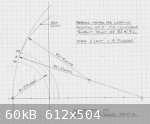
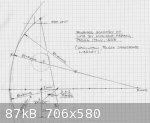
|
|
|
jdowning
Oud Junkie
    
Posts: 3485
Registered: 8-2-2006
Location: Ontario, Canada
Member Is Offline
Mood: No Mood
|
|
The proposed geometry of another lute by Harton is shown in the attached image - this time derived from a full size drawing of the instrument (by
luthiers Miranda and Stephen Murphy in 1975). The lute was made in 1599, Padua, Italy and is artifact #1808 in the Bologna Museo Civico.
String length is 69.7 cm and the fingerboard length is the same as the distance between the neck joint and centre of rosette. The bridge is roughly
made and so may not be original and is placed midway between the widest part of the sound board and the bottom of the bowl which may not be exactly
the original position.
The geometry is self explanatory. The upper sound board profile is an oval created by arcs of radius R1 and R2 equal to 7 and 4 units respectively -
point X being determined by an arc of radius 2 units. (R1 in this case passes very close to the centre of the rosette C).
The lower sound board profile is created by blending arcs of radius R3, R4 and R5 - R5 being the distance CD from the centre of the rosette to the
widest part of the sound board.
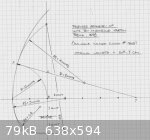
|
|
|
jdowning
Oud Junkie
    
Posts: 3485
Registered: 8-2-2006
Location: Ontario, Canada
Member Is Offline
Mood: No Mood
|
|
Looking at another original lute from the late 16th C - made in Padua by renowned luthier Wendelin Tieffenbrucker (a.k.a. Wendelio Venere). This is a
little Descant lute - 7 courses string length 44.1 cm.
The attached image of the lute is rather old and of poor quality. Note that the neck should be fitted with 8 frets not 6 as shown.
Working from a full size drawing by luthier Stephen Murphy it can be seen from the proposed geometry in the attached image that - like the
contemporary Harton lutes (also made in Padua, Italy) - the upper sound board profile is oval created from two contiguous arcs radius R1 and R2 equal
to 7 and 4 units respectively. (Note that 4 units is equal to the sound board maximum width or - if preferred - 16 'finger' units).
Contiguous point X for the arcs is determined by R equal to 2 units.
The lower sound board profile - in this case is made by blending three arcs R1, R3 and R4 - R4 being equal to the distance from the centre of the
rosette to the widest part of the sound board CD.
The bridge (probably not original?) is located midway between the widest part of the sound board and the bottom of the bowl.
The distances from neck joint to sound hole centre NC and sound hole centre to bridge CB are equal and so conform to the traditional division of the
string length of an oud into 3 parts. However - in this case - the neck has been increased in length to accommodate 8 frets, typical for a lute of
this period.

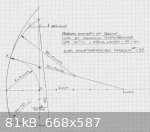
|
|
|
jdowning
Oud Junkie
    
Posts: 3485
Registered: 8-2-2006
Location: Ontario, Canada
Member Is Offline
Mood: No Mood
|
|
Note that luthier Stephen Murphy is located in Provence, France web site:
http://www.murphylutes.com
|
|
|
jdowning
Oud Junkie
    
Posts: 3485
Registered: 8-2-2006
Location: Ontario, Canada
Member Is Offline
Mood: No Mood
|
|
For those who may be interested - a complete facsimile of a first edition of Albrecht Dürer's 'Underweysung der Messung ...." of 1525 (previously
reported in this thread) is available for viewing in high resolution on line or for free download (page by page) at
http://www.commons.wikimedia.org/wiki/Category:Underweysung_der_Mes...
Or alternatively there is an original first edition of the book for sale from booksellers 'Buddenbrooks' of Boston for a mere $52,250 (plus $14
shipping and handling!).
The book is written in old German and comprises 4 books in one volume - dealing with aspects of Euclidean geometry of practical use for artists,
architects and artisans.
It is said that Dürer was confused about the shape of an ellipse by incorrectly referring to it as egg shaped. However, on reading the original text
of Underweysung, what Dürer actually says about an elliptical curve is "Die Elipsis will ich ein eyer lini nennen/darumb das sie schner einem ey
gleich ist" or "I will call the Ellipse an 'egg line' because it is very nearly the same (shape) as an egg". He does not say that the ellipse and egg
shapes are identical only that they are very nearly the same. Furthermore he correctly names the ellipse shape, on the page describing its
construction, as "the ellipse line" - so there is no confusion in Dürer's mind at all.
Dürer earlier in Book 1 also describes the construction of an oval or egg shape (see previous posting on this thread). To test the validity of
Dürer's claim the attached image is his construction of an oval on which I have placed an overlay of a true ellipse (quadrant) - the shape marked
with little x's.
From this it can be seen that the match is indeed a close one. The significance of this is that an almost perfect elliptical curve can be simply
created from a series of arcs of a circle using only dividers and a straight edge - which is most likely how the lute makers of the late 16th C
determined the upper sound board profiles of this kind of lute.
I have yet to find images of any ouds of this particular shape so - if the European lute was developed from the Medieval oud - this may be the point
in time at which the two instruments finally went their separate ways from a design point of view?
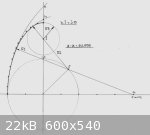
|
|
|
Ronny Andersson
Oud Junkie
    
Posts: 724
Registered: 8-15-2003
Location: Sweden
Member Is Offline
Mood: No Mood
|
|
Here a late 19th century Kuitra from Morocco.
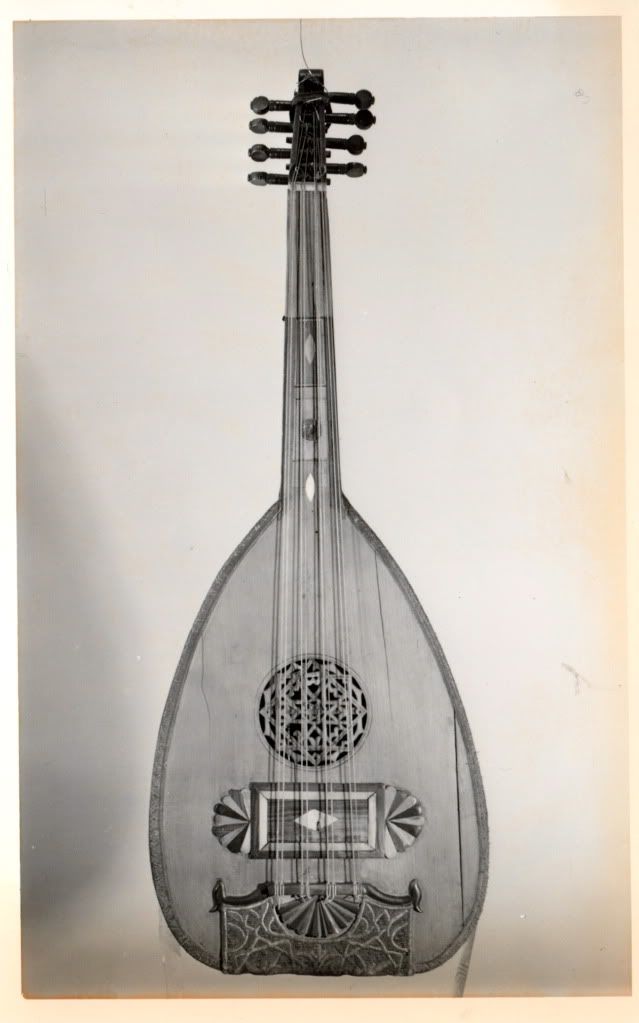
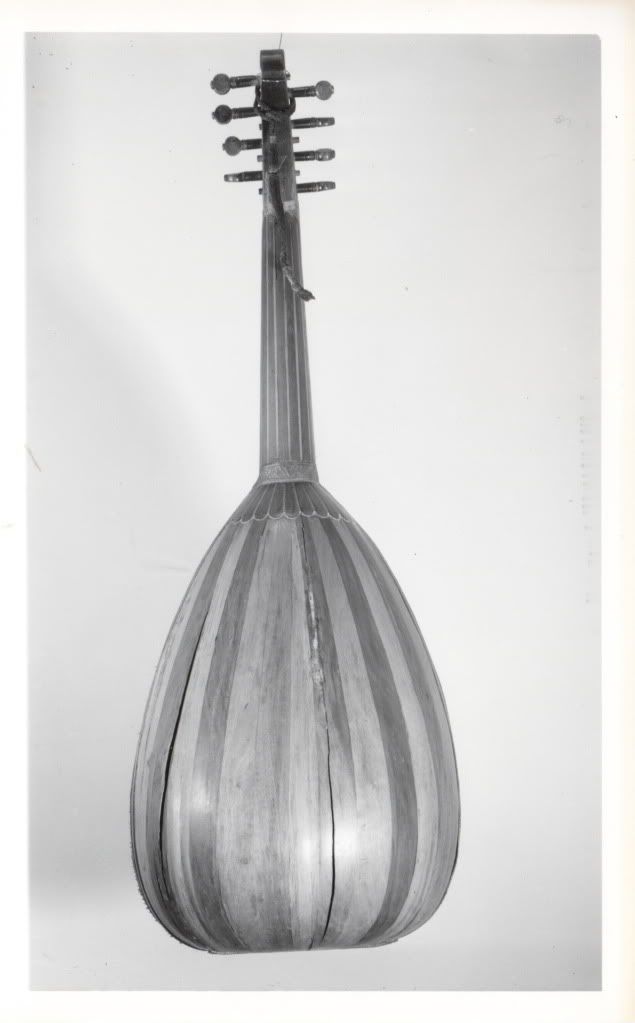
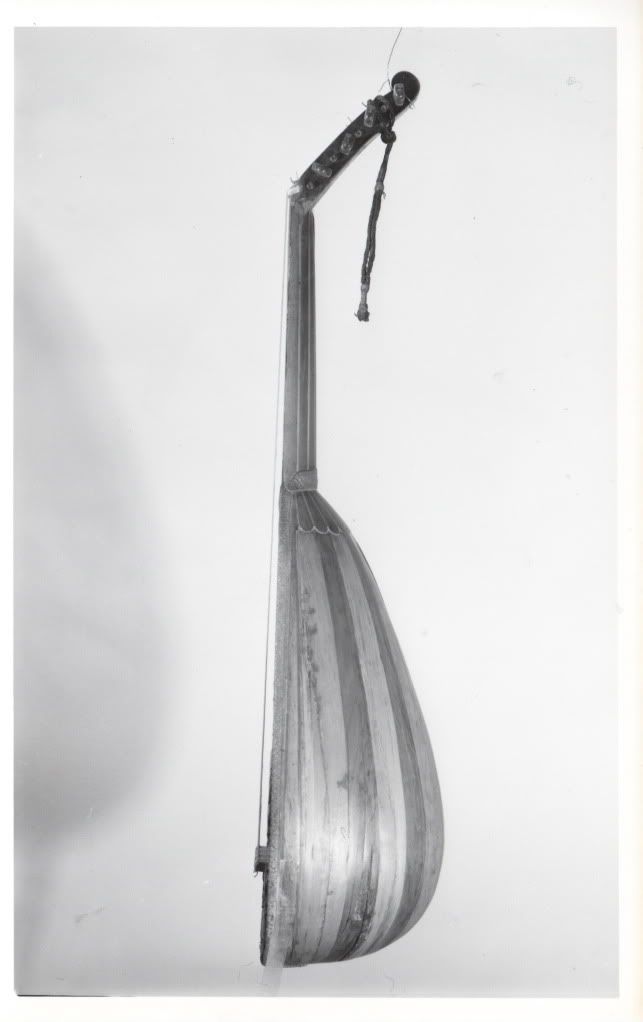
Best wishes
Ronny
|
|
|
jdowning
Oud Junkie
    
Posts: 3485
Registered: 8-2-2006
Location: Ontario, Canada
Member Is Offline
Mood: No Mood
|
|
Thanks for posting the detailed images Ronny. Interesting instrument. Do you have any further details (string length etc.) or know where the oud is
located?
The edging of the sound board looks as if it might be covered with embossed leather strips glued in place (?) similar to the parchment 'lace' found on
17th C lutes. Straight pegbox and 'cut in' rosette are other lute like features. I assume that the instrument also originally had tied on frets?
|
|
|
Ronny Andersson
Oud Junkie
    
Posts: 724
Registered: 8-15-2003
Location: Sweden
Member Is Offline
Mood: No Mood
|
|
John,The lute is in the collections of the Stockholm Music Museum The photos I got about 10 years ago when I asked about the lute after becoming
aware of its existence in a book from 1928. Unfortunately I had no more information about the lute than it was from Morocco. It is not on display as
well as many of the most interesting instruments. I know many lnstrument has been damaged due to poor storage and some ten years ago there was a TV
program that showed a lot of destroyed cracked instruments.
The decorations at the bridge is made of cloth and probably edge decoration as well. I have seen identical decorations on other Kuitras.

Best wishes
Ronny
|
|
|
jdowning
Oud Junkie
    
Posts: 3485
Registered: 8-2-2006
Location: Ontario, Canada
Member Is Offline
Mood: No Mood
|
|
An interesting old Syrian oud owned by Yair Dalal is currently undergoing restoration by Yaron Naor.
Although details of the proposed geometrical construction has already been posted on Yaron's thread 'Repairing a "Nahhat" oud' it is appropriate to
include the geometry as part of this thread - for comparison with what has already been posted.
The attached image of the geometry is largely self explanatory but more details can also be found on Yaron's thread.
Note that the geometry is based upon a 3:4:5 Pythagorean right triangle and that the profile is an oval in construction - created from conjunct arcs
of a circle - similar in concept to some of the old surviving lutes of the late 16th C as previously detailed on this thread.
Note also that the entire geometry is created using only a straight edge and dividers - no measurement with a ruler being required although the
luthier may have taken an ancient Persian measure of a 'finger' (28 fingers to the cubit) as a starting point for creating the design (1 unit = 4
'fingers').
For those interested in some of the history behind ancient units of measurement that may have influenced oud and lute design I attach a copy of a
recent article written for FoMRHI on the subject " Ancient Metrology, Ibn al-Tahhan and the Maler and Frei Lutes"
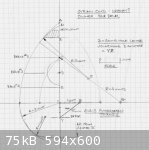
Attachment: FoMRHI Comm Ancient Metrology.pdf (839kB)
This file has been downloaded 647 times
|
|
|
jdowning
Oud Junkie
    
Posts: 3485
Registered: 8-2-2006
Location: Ontario, Canada
Member Is Offline
Mood: No Mood
|
|
...... and here is part 2 for those interested.
Attachment: FoMRHI Metrology 2.pdf (505kB)
This file has been downloaded 479 times
|
|
|
jdowning
Oud Junkie
    
Posts: 3485
Registered: 8-2-2006
Location: Ontario, Canada
Member Is Offline
Mood: No Mood
|
|
.... and here is the proposed bracing geometry.
See "Repairing a 'Nahhat' oud" for more detail.
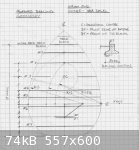
|
|
|
jdowning
Oud Junkie
    
Posts: 3485
Registered: 8-2-2006
Location: Ontario, Canada
Member Is Offline
Mood: No Mood
|
|
Having recently had the opportunity to read a full English translation of Epistle 5 (music) of the Rasa'il of the Ikhwan al-Safa ('Epistles of the
Brethren of Purity on Music', Owen Wright, Oxford University Press, 2010) I have updated my proposed geometry of an oud as described by the Ikhwan
al-Safa originally posted on this thread two years ago.
To the Ikhwan al-Safa numbers had important significance in the Universal grand scheme of things - for example 4 (four seasons, four elements, four
humours) and 8 as well as multiples of those numbers. The number 6 also had significance as the first 'perfect number' (a number equal to the sum of
its divisors e.g 6 = 1 +2 +3) and 28 is the next 'perfect number'.
The sphere (or circle) was considered to be the most perfect geometrical figure followed by the cube (6 equal square faces, 8 equal plane angles, 12
parallel and equal intersections and 24 equal right angles). The four numbers of the cube 24:12:8:6 applied to string lengths give the first four
tones of the harmonic series.... etc. etc.
The geometry of the oud is represented by linear proportion. The size of the linear unit of measurement is, therefore, not important. However, just
for interest, a unit value of 2.25 cm has been chosen which is the ancient standard 'finger' measure derived from the 9th C Arabic (black) cubit
measure equal to just over 540 mm (24 finger widths to the cubit). This gives a reasonable string length of about 630 mm. Note also that the length of
the sound board is equal to the Arabic (black) cubit linear measure.
The geometry of the oud sound board is based upon a circle of 8 units radius according to the attached scale drawing. The geometry is largely self
explanatory.
I have added a proposed bridge position located midway between the widest point of the oud sound board and the bottom of the bowl. This is 1/6 of the
total length of the sound board which happens to correspond to the bridge positions on some surviving lutes of the 16th/17 C.
I have also added a single soundhole of 4 units diameter with centre located 6 units from the widest point of the sound board (compare this to the
19th C Al-Arja oud geometry previously posted).
[file]26615[/file]
|
|
|
| Pages:
1
2
3
4
5 |